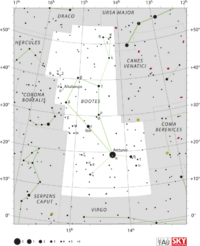Astronomy:Beta Boötis
A star chart showing the position of β Boötis (circled) | |
| Observation data Equinox J2000.0]] (ICRS) | |
|---|---|
| Constellation | Boötes |
| Right ascension | 15h 01m 56.76238s[1] |
| Declination | +40° 23′ 26.0406″[1] |
| Apparent magnitude (V) | 3.488[2] |
| Characteristics | |
| Spectral type | G8IIIa[3] |
| U−B color index | +0.75[2] |
| B−V color index | +0.94[2] |
| Variable type | Flare star[4] |
| Astrometry | |
| Radial velocity (Rv) | –18.35[5] km/s |
| Proper motion (μ) | RA: –40.15[1] mas/yr Dec.: –28.86[1] mas/yr |
| Parallax (π) | 14.48 ± 0.14[1] mas |
| Distance | 225 ± 2 ly (69.1 ± 0.7 pc) |
| Absolute magnitude (MV) | –0.70[6] |
| Details | |
| Mass | 3.4 ± 0.2[4] M☉ |
| Radius | 21.5 ± 1.0[4] R☉ |
| Luminosity | 170[5]–194[6] L☉ |
| Surface gravity (log g) | 2.40 ± 0.20[4] cgs |
| Temperature | 4,932[5] K |
| Metallicity [Fe/H] | –0.13[5] dex |
| Rotation | 200 ± 10 days[4] |
| Rotational velocity (v sin i) | 4.10 ± 1.0[4] km/s |
| Age | 240[4]–251[6] Myr |
| Other designations | |
| Database references | |
| SIMBAD | data |
Beta Boötis, Latinized from β Boötis, and also named Nekkar /ˈnɛkɑːr/,[7] is a star in the northern constellation of Boötes. It has an apparent visual magnitude of 3.5,[2] making it one of the brighter members of the constellation. In the modern constellation, it marks the head of Boötis the herdsman.[8] Based upon parallax measurements obtained during the Hipparcos mission, this star is approximately 225 light-years (69 parsecs) from the Sun.[1] At that distance, the magnitude of the star is reduced by 0.06 from extinction caused by intervening gas and dust.[6]
Nomenclature
β Boötis (Latinised to Beta Boötis) is the star's Bayer designation.
It bore the traditional name Nekkar or Nakkar derived from the Arabic name for the constellation: Al Baḳḳār 'the Herdsman'.[8] In 2016, the International Astronomical Union organized a Working Group on Star Names (WGSN)[9] to catalogue and standardize proper names for stars. The WGSN approved the name Nekkar for this star on 21 August 2016 and it is now so included in the List of IAU-approved Star Names.[7]
Properties
Nakkar has more than three times the mass of the Sun and greater than 21 times the Sun's radius. (König et al. (2006) give it 3.4 solar masses,[4] while Tetzlaff et al. (2011) list a higher estimated mass of 5.0 ± 1.5[10] solar masses and Takeda et al. (2008) show it as 3.24[6] solar masses.) At the estimated age of 240–251 million years, it has evolved into a giant star with a stellar classification of G8 IIIa.[3] The star is radiating around 170[5]–194[6] times as much luminosity as the Sun from its outer envelope at an effective temperature of 4,932 K.[5] This heat gives it the yellow-hued glow of a G-type star. It has an estimated rotation period of about 200 days and the pole is inclined 28° ± 6° to the line of sight from the Earth.[4]
In 1993, the ROSAT satellite was used to observe an X-ray flare on Beta Boötis, which released an estimated 1.7 × 1032 erg. This was the first such observation for a low-activity star of this type. The flare may be explained by an as yet unobserved M-type dwarf companion star.[11]
References
- ↑ 1.0 1.1 1.2 1.3 1.4 1.5 van Leeuwen, F. (November 2007). "Validation of the new Hipparcos reduction". Astronomy and Astrophysics 474 (2): 653–664. doi:10.1051/0004-6361:20078357. Bibcode: 2007A&A...474..653V.
- ↑ 2.0 2.1 2.2 2.3 Fernie, J. D. (May 1983), "New UBVRI photometry for 900 supergiants", Astrophysical Journal Supplement Series 52: 7–22, doi:10.1086/190856, Bibcode: 1983ApJS...52....7F
- ↑ 3.0 3.1 3.2 "bet Boo -- Flare Star", SIMBAD (Centre de Données astronomiques de Strasbourg), http://simbad.u-strasbg.fr/simbad/sim-id?Ident=beta+bootis, retrieved 2011-11-28
- ↑ 4.0 4.1 4.2 4.3 4.4 4.5 4.6 4.7 4.8 König, B. et al. (January 2006), "Spectral synthesis analysis and radial velocity study of the northern F-, G- and K-type flare stars", Monthly Notices of the Royal Astronomical Society 365 (3): 1050–1056, doi:10.1111/j.1365-2966.2005.09796.x, Bibcode: 2006MNRAS.365.1050K
- ↑ 5.0 5.1 5.2 5.3 5.4 5.5 Massarotti, Alessandro et al. (January 2008), "Rotational and Radial Velocities for a Sample of 761 HIPPARCOS Giants and the Role of Binarity", The Astronomical Journal 135 (1): 209–231, doi:10.1088/0004-6256/135/1/209, Bibcode: 2008AJ....135..209M
- ↑ 6.0 6.1 6.2 6.3 6.4 6.5 Takeda, Yoichi; Sato, Bun'ei; Murata, Daisuke (August 2008), "Stellar parameters and elemental abundances of late-G giants", Publications of the Astronomical Society of Japan 60 (4): 781–802, doi:10.1093/pasj/60.4.781, Bibcode: 2008PASJ...60..781T
- ↑ 7.0 7.1 "Naming Stars". IAU.org. https://www.iau.org/public/themes/naming_stars/.
- ↑ 8.0 8.1 Allen, Richard Hinckley (1899), Star-names and their meanings, G. E. Stechert, p. 103, https://books.google.com/books?id=5xQuAAAAIAAJ&pg=RA103, retrieved 2011-11-28
- ↑ IAU Working Group on Star Names (WGSN), International Astronomical Union, https://www.iau.org/science/scientific_bodies/working_groups/280/, retrieved 22 May 2016.
- ↑ Tetzlaff, N.; Neuhäuser, R.; Hohle, M. M. (January 2011), "A catalogue of young runaway Hipparcos stars within 3 kpc from the Sun", Monthly Notices of the Royal Astronomical Society 410 (1): 190–200, doi:10.1111/j.1365-2966.2010.17434.x, Bibcode: 2011MNRAS.410..190T
- ↑ Huensch, M.; Reimers, D. (April 1995), "Detection of an X-ray flare on the low-activity G 8 III-type giant β Boo", Astronomy and Astrophysics 296: 509–513, Bibcode: 1995A&A...296..509H
External links
 |


